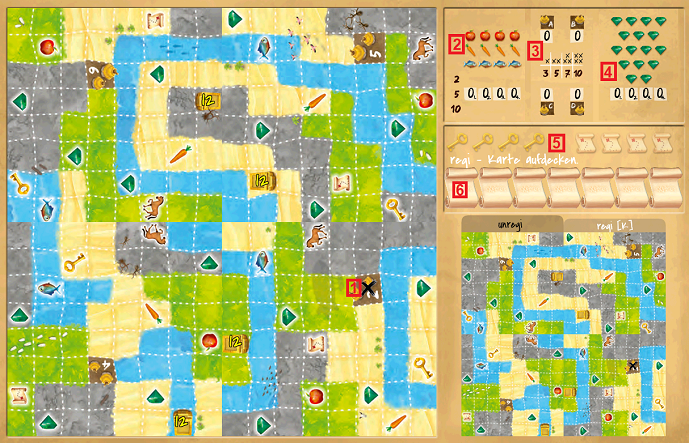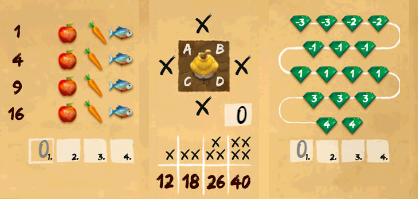Explorers
Explorers (Originalregel)
The game
At Explorers you explore a new world as explorers, travel through different landscapes and collect resources and objects that bring you benefits or win points.
The rules
The field

- Start-Dorf
- Value Proviant
- Valuation for villages
- Gemstones
- Keys and maps
- Exploration maps
Before the start of the game
Starting from the starting village, everyone puts 3 crosses in a terrain type.
Game sequence
The game runs over 4 rounds each with 7 trains per round.

At the beginning of each round, 7 exploration cards are covered.
The starter covers the first card as an active player, selects one of the two terrain types on the map and sets 3 crosses on its schedule.
All other players put either 3 crosses on the terrain type that the active game has not chosen or 2 crosses on the same terrain type as the active player.
Rules for setting crosses:
- A cross must always be horizontal or vertical (orthogonal) adjacent to an already existing cross
The cross will be set (including the start village).
- It is not obligatory that all crosses of a train are set adjacent to one another.
- Each cross of a train must be set to the same terrain type (an exception is the Joker card).

Joker cards show 2 terrain duos. Players choose the rules according to one of the duos and may distribute their 3, or 2 crosses on the two terrain types.
Then the next player as an active player covers the next exploration card, selects a terrain type, etc.
The round ends when all 7 exploration cards are uncovered and negotiated.
The winning points for Proviant and Gemstones are entered.
The next player will start the next round.
Playing
The game ends after the 4th round. All villages are valued and all other points added to Proviant, Gems and Temples.
The player with most points wins the game. In case of disagreement, the one who used the least maps wins. Unused keys and maps no longer give points.
Places and objects
Whoever puts a cross on a field with an object benefits from its effect:
Key

A key allows to put a cross on a temple later (also on the same train).
Map

Maps can be used in a later train to ignore the terrain type specified on the exploration map and instead put 4 crosses on another terrain type.
Horse

Put a cross on a field of any terrain type immediately. This field must furthermore lie orthogonally adjacent to an already set cross. If an object is present in this field, profit from its effect.
Proviant



The corresponding proviant is crossed on the value plate. It is divided into 4 columns, one for each round.
A proviant can only be crossed on the landscape if it is still available in the column of the current round.
At the end of each round, players receive 2, 5 or 10 points for 1, 2 or 3 different proviant, which were crossed on the score plate in this round.
Gemstone

Place a cross on a precious stone on the small plate. At the end of each round, players get as many points as gemstones were crossed on their scoreboard.
Temple

Players can only put a cross on a temple if they still have an unused key.
To explore the temple, you get the number of points standing on the temple.
If you put a cross on a temple, all other players will reduce the score for this temple. You can also set a cross on this temple, but get fewer points.
If several players put a cross on the same temple on the same train, they will get all the scores available at that time.
For the remaining players, the score is reduced according to the number of players who crossed this temple.
village

At the end of the game you get points for horizontal or vertical crosses around the villages.
For each village there are 3, 5, 7 or 10 points for 1, 2, 3 or 4 adjacent crosses.
Options
Side B (Expert variant)

Proviant: At the end of each round you will receive 1, 4, 9 or 16 points for 1, 2, 3 or 4 proviant of the appropriate variety, which were crossed in the matching column on the score plate in this round. In the first round, no proviant is collected and no points are awarded, in the 2nd round only apples etc.
Gemstones: The gems at the beginning of the score line are filled with negative numbers (minimum points). At the end of each round all still open negative or all collected positive gems are counted together.
Temple: The temple rules remain the same, but each temple always provides only 8 points. In addition, players will receive a number of crosses (depending on when they explore the temple), which they will be allowed to place at the end of their course on a terrain type of their choice.
Villages: You value exactly one village – with the smallest number of crosses adjacent to each other. You will receive 12, 18, 26 or 40 points for 1, 2, 3 or 4 adjacent crosses at this village.
Order platelets (level 1 - 3)
Depending on the degree of difficulty, 1-3 order plates are revealed, which apply to all players and offer new possibilities to score points.
To see the order platelets you scroll to the right in the value range.



receive 6, 8 and 16 points if at the end of the game you have set crosses on none of the imaged objects.

Get 12 points when you set a closed row of crosses (16 crosses, horizontal or vertical).




Depending on how many of the required objects you have collected at the end of the game you will receive the corresponding points (e.g. apples, villages with 4 adjacent crosses, sets of 3 different types of proviant, crosses in the corners of the landscape).



Once you meet the required condition, you will receive the highest available score (e.g. 3 horses, 3 carrots and 3 apples, at least 3 crosses on each quadrant of the landscape).
If several players reach the target on the same train, they will receive all the highest available scores at this time. For the remaining players, the points are deleted accordingly.



Get 1 point for each cross in the longest vertical/ horizontal/diagonal continuous line.

Get 4, 8, 13 or 20 points for the largest contiguous square from crosses.
Get 10 points if you have set at least one cross in all areas of a terrain type.
Thanks to regi for the guide
